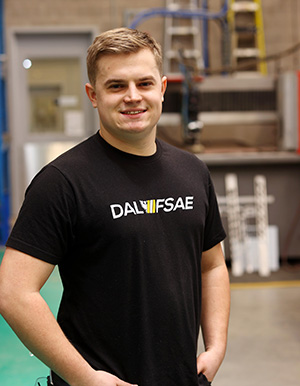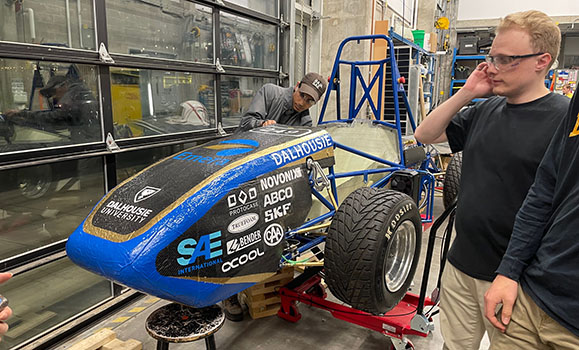On a warm June day in Michigan, 16 members of DalhousieŌĆÖs Formula Society of Automotive Engineers (FSAE) team proudly raised a Nova Scotian flag in front of the Dal's first-ever electric vehicle.
Now, two months after competing with the vehicle at the Formula SAE Electric Competition in Michigan, team captain and graduate student Mitch Gregory reflects back on his teamŌĆÖs incredible experience at the event.
ŌĆ£My favourite memory of the year is seeing the team on the Michigan International Speedway with the car for that team photo,ŌĆØ says Gregory, who has finally seen dreams become a reality after five years as a member of the
ŌĆ£After many late nights, thousands of kilometers of travel, hundreds of hours of discussion, design, and fabrication, we had finally made it to the Formula SAE Electric competition,ŌĆØ he says. ŌĆ£To be amongst the other teams on the track to celebrate the event was amazing.ŌĆØ
Formula SAE competitions challenge teams of university students to build and design formula-style vehicles. Each competition gives teams the chance to demonstrate their creativity and engineering skills against other university teams from around the world as they work to meet specific design specifications.
Although the Dal team didn't end up racing its vehicle, Gregory it was an educational experience and set a solid foundation for next year.
ŌĆ£We had a tremendous time with a lot of success and failure,ŌĆØ says Gregory. ŌĆ£Meeting other teams from across Canada and beyond, gaining valuable feedback from experienced judges, and putting our systems to the test in a one-of-a-kind environment was incredible.ŌĆØ
Going electric
ItŌĆÖs been a long road for the Dal FSAE team, which strived for years to build an electric-powered vehicle. Since 2007, the team has built ten gas-powered cars and provided more than 300 engineering students with hands-on experience in areas such as automotive, manufacturing, design and leadership. Going electric was a new and exciting challenge for the team.
 ŌĆ£It started off as a drawing, probably on the back of a napkin or in some class note, then it became a CAD and it looks pretty close to the final design," says Gregory, shown right. "But things change, and you donŌĆÖt get the full picture until it all comes together. When you finally see it as an assembled car, thatŌĆÖs special. You get tingles down your neck.ŌĆØ
ŌĆ£It started off as a drawing, probably on the back of a napkin or in some class note, then it became a CAD and it looks pretty close to the final design," says Gregory, shown right. "But things change, and you donŌĆÖt get the full picture until it all comes together. When you finally see it as an assembled car, thatŌĆÖs special. You get tingles down your neck.ŌĆØ
Gregory joined Dal's FSAE team 2019 as a third-year mechanical engineering student to pursue his passion for clean-energy technologies. Though one of the youngest members of the team at the time, he had big dreams and pushed the team to move from an internal combustion engine car to an electric-powered vehicle.
Five years later and now a graduate student, Gregory says he feels a great sense of accomplishment and satisfaction when he looks back at how far the team has come.╠²
ŌĆ£I hope this project will inspire and educate a new generation of students skilled in electrifying our future transport, energy systems, and beyond,ŌĆØ he says.
The next generation
╠²
With EmeraŌĆÖs blue and yellow logo now shining front and centre on the new electric vehicle, Gregory is quick to praise the Halifax-based company for a generous $70,000 sponsorship that changed the teamŌĆÖs course of action. The team used Emera's support to upgrade equipment and purchase the essential electric components for their vehicle, including motor and control electronics.╠²
ŌĆ£Without sponsors like Emera supporting our student experiential learning, student teams like the Formula SAE electric vehicle team would not exist,ŌĆØ says Gregory. ŌĆ£The team would like to say a heartfelt thank you to Emera for their generous support of our teamŌĆÖs transition to an electric drive train. EmeraŌĆÖs support enabled us to make the transition to a zero-emission system, develop skills and knowledge around cutting edge technologies, and build a faster race car.ŌĆØ
EmeraŌĆÖs sponsorship builds on a $10-million investment the company made to the Emera ideaHUB on Dal's Sexton Campus.
ŌĆ£We were thrilled to support the Dal FSAE team in the development of their first electric vehicle,ŌĆØ says Jennifer Parker, senior director of corporate communications at Emera. ŌĆ£This partnership is an investment in the next generation of engineers, fostering the innovative thinking needed to achieve net-zero CO2 emissions by 2050. To see this work happening right here in Halifax is incredibly exciting for the entire Atlantic region.ŌĆØ
 ╠²
╠²
The next lap
Gregory, who is stepping down as captain, says most of the team's other key members will be retuning again this year, building from lessons learned in competition this summer.
ŌĆ£Having identified over 20 technical development areas, we plan on growing the team from around 13 core members up to over 25 core members,ŌĆØ he says.
ŌĆ£We want to compete with the top teams in Canada. To be competitive we need to get more points through iterative design and lots of testing."
Jumping into the driverŌĆÖs seat as Dal FSAE captain is mechanical engineering student, James McIntosh.
Dal FSAE will begin recruiting new members to the team beginning in September.╠²

